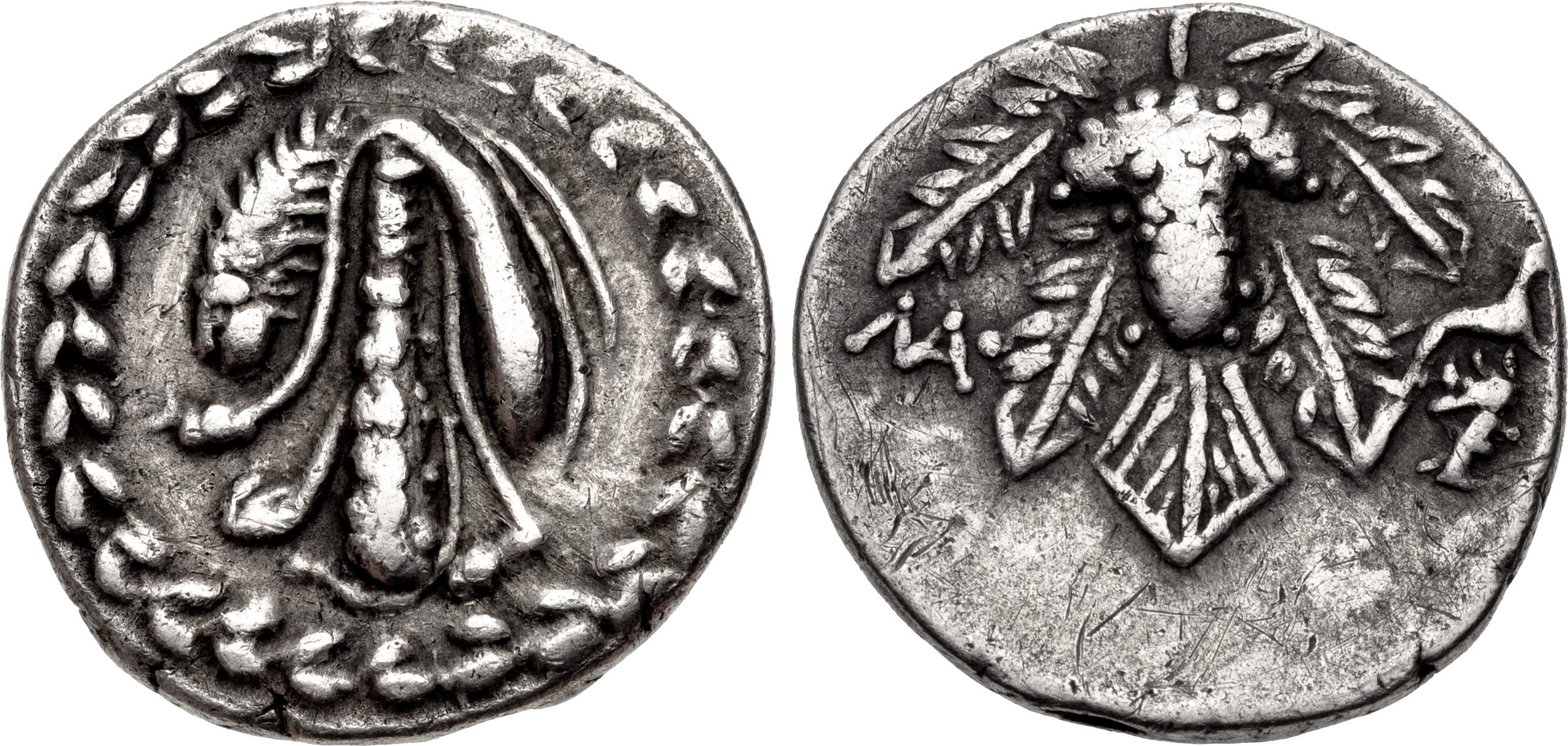H 253a - Laodiceia ad Lycum, silver, half cistophori (160-145 BCE) Kleiner & Noe
From SILVER
160 BCE - 145 BCE Silver 587 kg
Description
| ObverseInscription or printing placed on the obverse.: | Lion's skin draped over club, all within wreath |
| ReverseInscription or printing placed on the reverse.: | Grape bunch on vine, to lower right, wolf standing right above head of Tyche right |
Mint and issuing power
| MintIdentifies the place of manufacture or issue of a numismatic object.: | Laodiceia ad Lycum | Ancient regionAncient region.: | Phrygia | Modern countryModern country: Turkey | AuthorityIdentifies the issuing power. The authority can be "pretended" when the name or the portrait of X is on the coin but he/she was not the issuing power. It can also be "uncertain" when there is no mention of X on the coin but he/she was the issuing power according to the historical sources: | Attalid Kingdom |
Chronology
| FromIdentifies the initial date in a range assigned in a numismatic context. | 160 BCE | toIdentifies the final date in a range assigned in a numismatic context.. | 145 BCE | PeriodTime period of the numismatic object.: Hellenistic 323-30 BC |
Physical description
| MetalThe physical material (usually metal) from which an object is made.: | Silver |
Median weightMedian of the weights of numismatic objects (in grams). in grams | 6.10 | DenominationTerm indicating the value of a numismatic object. Examples: tetradrachm, chalkous, denarius.: | didrachm |
StandardStandard.: | Cistophoric |
Image

H253a Laodiceia half cistophori.jpg [1]
References
| Die study referencePublication of the study: | Kleiner - Noe 19771Kleiner - Noe 1977 | ||
| Coin series referenceReference to coin series study: | RQEMH2RQEMH, n° 253a, HGC 73HGC 7, n° 734 | ||
Obverse dies distribution
no distribution is available
Reverse dies distribution
no distribution is available
Quantification
| Number of obversesNumber of obverse dies. ᵖ (o) | 2 | Number of singletons (o1)The number of singleton coins. ᵖ | |
| Number of reverse diesNumber of reverse dies. (r) | 2 | Number of coinsNumber of coins. (n) | 3 |
| Coins per obverse dieNumber of coins per obverse die. (n/o) | 1.5 | Coins per reverse dieNumber of coins per reverse die. (n/r) | 1.5 |
| Reverse per obverse ratioRatio of obverse dies divided by reverse dies. (r/o) | 1 | Percentage of singletons (o1)number of coins (n) divided by the number of singletons (o1) ᵖ | % |
| Original number of dies (O) (Carter 1983 formula)The estimation of the number of coins according to Carter 1983 ᵖ | 4.81 | Coins struck if 20,000 as average productivity per dieCoins made if the average productivity for obverses (according to Carter) is 20,000. ᵖ | 96,200 |
| Original number of dies (O) (Esty 2011 formula)The estimation of the number of coins according to the singleton formula in Esty 2011 ᵖ (O) | 6 | Survival rate if 20,000 as average productivity per dieSurvival rate if average productivity is 20,000. ᵖ | 0.00003 |
| Coverage (o = % of O) (Esty 1984 formula)Esty 1984 - coverage (% of O) ᵖ (o = % of O) | % | Die productivity if survival rate 1/2,000Average productivity if survival rate is 1/2,000. ᵖ | 1,247.4 |
| Weight of silver (in kg) if 20,000 coins per die (O = Carter formula)Carter 1983 * Median weight * 20000 (*10 if gold or electrum) ᵖ | 587 kg <br /> 587 kg | Die productivity if survival rate 1/5,000Average productivity if survival rate is 1/5,000. ᵖ | 3,118.5 |
Remarks
Most likely one single workstation
References
- ^ Kleiner, Fred S. - Noe, Sydney P. (1977), The early Cistophoric coinage, Numismatic Studies 14, New York, 129 p., 38 pl.
- ^ Callataÿ, François de (1997), Recueil quantitatif des émissions monétaires hellénistiques, Numismatique Romaine, Wetteren, X + 341 p.
- ^ Hoover, Oliver D. (2012), Handbook of Greek Coinages. 7. Coins of northern and Central Anatolia - Pontos, Paphlagonia, Bithynia, Phrygia, Galatia, lykaonia, and Kappadokia (with Kolchis and the Kimmerian bosporos), Lancaster, lxxxii, 352 p. : ill. ; 23 cm.